Transforming Ontology Web Language Elements into Common Terminology Service 2 Terminology Resources
Abstract
1. Introduction
2. Materials and Methods
2.1. Ontology Elements and Relations
- Class: Every single object belonging to the domain.
- Annotation Properties: Further information purely attributable to the Class itself, independent of the others. Examples of annotation properties are synonym, comment, and label.
- Object Properties: A restriction, which places a limit on the values of a certain Class that respects a certain Property. In most cases, the considered Property is defined within the ontology, and so its logical value scope only within it.
2.2. CTS2 Terminology Resources and Profiles
- Definition: An explanation of the intended meaning of a concept. An EntityDescription may have multiple definitions, each derived from a different source, represented in a different language or having a different purpose.
- Parent: The set of direct “parents” defined in the same CodeSystemVersion. It is the responsibility of the service to determine what predicate(s) represent “parent/child” relationships.
- Property: Additional “non-semantic” (annotation) assertions about the entity being described that do not fit into the other categories.
- EntityType: The set of type(s) a resource can take, and it should include owl:Class, owl:Individual, rdf:Property, or skos:Concept, although it may carry many other types as well.
- EquivalentEntity: An entity that has been determined to be equivalent to the about entity in the context.
- Predicate: The name or URI of the property predicate. It can be literal or an EntityDescription itself, namely, an Annotation Property or an Object Property.
- Value: The target(s) of the property. Note that this can only represent the literal format of the property. The details about the original property will be found in the CorrespondingStatement if the CTS2 implementation supports the statement profile. So, the attribute value of a property is of Class StatementTarget, and it can be from three of the following types:
- ○
- Literal Target: When the statement type is LITERAL. It can be used for properties like the entity “label” or “comment”.
- ○
- Entity Reference Target: The URI and optional namespace/name when the target type is ENTITY. It can be used when a property refers to another entity.
- ○
- Resource Target: When the statement type is RESOURCE.
2.3. Translation Process Pipeline
- Create CodeSystem (I) using the CodeSystem Catalog Maintenance Service functional profile. Within this phase, we provided the following input parameters: Uniform Resource Identifier (URI), i.e., an external link of the resource; and Name, i.e., the identifier of the catalog that we want to create, to use locally (Enterprise VP).
- Create CodeSystemVersion (II) using the CodeSystemVersion Catalog Maintenance Service. Equally to the CodeSystem, one of the input parameters is Name, which uniquely identifies the specific version in the CodeSystem. The other input parameter that we considered is VersionOf, which contains the name or URI of the CodeSystem that the version belongs to (Information VP).
- Create EntityDescription (III) using the Entity Description Maintenance Service. For each entity, we set two important input parameters, as follows: EntityID, i.e., the entity code and/or namespace identifier; and DescribingCodeSystemVersion, which contains the URI or local identifier of the CodeSystemVersion this entity belongs to (Computational VP).
- Update EntityDescription (IV) using the Entity Description Maintenance Service. We completed each entity with all of the information linked to the single ontology class or property. In general, the components of an ontology resource can be distinguished in the following: (i) the components directly mappable into an element of the CTS2 EntityDescription, as displayed in Table 1; (ii) the components that could not fit into any predefined item, but which can be mapped into properties, as displayed in Table 2; and (iii) the components that could not fit into any predefined item, but which can be mapped into a CTS2 terminology resource, i.e., the properties devoted to Map elements among ontologies and/or other coding systems (Engineering VP).
| Ontology Concept Metadata | CTS2 Resource Metadata | Data Type |
|---|---|---|
| Example | .Example | List (0…N) |
| IsDefinedBy | .Definition | List (0…N) |
| SubClassOf | .Parent | Class (1…N) |
| EquivalentClass | .EquivalentEntity | Class (0…N) |
| Value Is a Text | Value Is an Entity | |
|---|---|---|
| Predicate is a text | The predicate contains the name and namespace of the statement predicate (type: EntityNameOrURI). The value element is a statement target of type LITERAL (type: Opaque-Data). | The predicate contains the name and namespace of the statement predicate (type: EntityName-OrURI). The value element is a statement target of type ENTITY (type: EntityNameOrURI). |
| Predicate is an Entity | The predicate contains the URI of the entity of type Annotation Property (type: EntityNameOrURI). The value element is a statement target of type LITERAL (type: Opaque-Data). | The predicate contains the URI of the entity of type Object Property (type: EntityNameOrURI). The value element is a statement target of type ENTITY (type: Entity-NameOrURI). |
- Create MapCatalogEntry (V) using the Map Catalog Maintenance Service. We provided the following input parameters: MapName, i.e., the name the new entry will be known as within a local context; FromCodeSystem, i.e., the name or URI of the CodeSystem that the “from” entities belong to; and ToCodeSystem, i.e., the name or URI of the CodeSystem that the “to” entities belong to.
- Create MapVersion (VI) using the Map Version Maintenance Service. The considered input parameters are as follows: MapVersionURI, i.e., the state of the resource version which can be “OPEN” or “FINAL”, and once the MapVersion is finalized it becomes immutable; MapVersioneName, i.e., an identifier to uniquely identify the MapVersion in a local context; FromCodeSystemVersion, i.e., the identifier (name or URI) of the specific CodeSystemVersion that the “from” entities belong to; and ToCodeSystemVersion, i.e., the identifier (name or URI) of the specific CodeSystemVersion that the “to” entities belong to.
- Create MapEntry (VII) using the Map Entry Maintenance Service. This is a set of mappings having the same entity identifier as MapFrom.
- Update MapEntry (VIII) using the Map Entry Maintenance Service. After we defined the entity of the “FROM” side, it is necessary to define one or more entities on the “TO” side, e.g., ones belonging to other CodeSystems. To perform that, the following two operations need to be executed.
- Add MapSet (VIII.i). Specifically, each MapEntry may contain one or more MapSets, defining rules and characteristics of the Map. Considering each Mapset, it is necessary to perform the function below.
- Add MapTarget (VIII.ii). In detail, the item MapTarget identifies the entity to include it in the Map on the “TO” side.
3. Results
4. Discussion
Supplementary Materials
Author Contributions
Funding
Institutional Review Board Statement
Informed Consent Statement
Data Availability Statement
Conflicts of Interest
References
- Mora, S.; Blobel, B.; Gazzarata, R.; Giacomini, M. CTS2 OWL: Mapping OWL Ontologies to CTS2 Terminology Resources. In pHealth 2022—Studies in Health Technology and Informatics; Blobel, B., Yang, B., Giacomini, M., Eds.; IOS Press: Amsterdam, The Netherlands, 2022; Volume 299, pp. 44–52. [Google Scholar]
- Blobel, B.; Oemig, F.; Ruotsalainen, P.; Lopez, D.M. Transformation of Health and Social Care Systems—An Interdisciplinary Approach toward a Foundational Architecture. Front. Med. 2022, 9, 802487. [Google Scholar] [CrossRef] [PubMed]
- ISO 23903:2021; Health Informatics—Interoperability and Integration Reference Architecture—Model and Framework. International Organization for Standardization: Geneva, Switzerland, 2021.
- ISO/IEC 10746:2009; Information Technology—Open Distributed Processing (All Parts). International Organization for Standardization: Geneva, Switzerland, 2009.
- Szolovits, P. An Overview of OWL, A Language for Knowledge Representation; Education Resources Information Center: Washington, DC, USA, 1977. [Google Scholar]
- Lara, R.; Roman, D.; Polleres, A.; Fensel, D. A Conceptual Comparison of WSMO and OWL-S. In Proceedings of the European Conference on Web Services, Erfurt, Germany, 27–30 September 2004; Springer: Berlin/Heidelberg, Germany, 2004; pp. 254–269. [Google Scholar]
- Gore, R.; Diallo, S.; Padilla, J. Conceve: Conceptual Modeling and Formal Validation for Everyone. ACM Trans. Model. Comput. Simul. TOMACS 2014, 24, 1–17. [Google Scholar] [CrossRef]
- Lezcano, L.; Sicilia, M.-A.; Rodríguez-Solano, C. Integrating Reasoning and Clinical Archetypes Using OWL Ontologies and SWRL Rules. J. Biomed. Inform. 2011, 44, 343–353. [Google Scholar] [CrossRef] [PubMed]
- Bagui, S. Mapping OWL to the Entity Relationship and Extended Entity Relationship Models. Int. J. Knowl. Web Intell. 2009, 1, 125–149. [Google Scholar] [CrossRef]
- Schulz, S.; Balkanyi, L.; Cornet, R.; Bodenreider, O. From Concept Representations to Ontologies: A Paradigm Shift in Health Informatics? Healthc. Inform. Res. 2013, 19, 235. [Google Scholar] [CrossRef][Green Version]
- Cardoso, S.D.; Pruski, C.; Da Silveira, M. Supporting Biomedical Ontology Evolution by Identifying Outdated Concepts and the Required Type of Change. J. Biomed. Inform. 2018, 87, 1–11. [Google Scholar] [CrossRef] [PubMed]
- Han, W.; Han, X.; Zhou, S.; Zhu, Q. The Development History and Research Tendency of Medical Informatics: Topic Evolution Analysis. JMIR Med. Inform. 2022, 10, e31918. [Google Scholar] [CrossRef] [PubMed]
- OMG COMMON TERMINOLOGY SERVICES 2TM (CTS2TM). Available online: https://www.omg.org/cts2/ (accessed on 22 June 2024).
- Gruber, T. What Is an Ontology? Stanford University: Stanford, CA, USA, 1993. [Google Scholar]
- Gruber, T.R. Toward Principles for the Design of Ontologies Used Forknowledge Sharing. In Proceedings of the International Workshop on Ontology, Padova, Italy, 17–19 March 1993. [Google Scholar]
- W3C—OWL Working Group Web Ontology Language (OWL). Available online: https://www.w3.org/TR/owl2-primer/ (accessed on 22 June 2024).
- W3C—RDF Working Group Resource Description Framework (RDF). Available online: https://www.w3.org/RDF/ (accessed on 22 June 2024).
- Robinson, P.N.; Mundlos, S. The Human Phenotype Ontology. Clin. Genet. 2010, 77, 525–534. [Google Scholar] [CrossRef] [PubMed]
- Cowell, L.G.; Smith, B. Infectious Disease Ontology. In Infectious Disease Informatics; Sintchenko, V., Ed.; 2010; Available online: https://link.springer.com/book/10.1007/978-1-4419-1327-2 (accessed on 20 June 2024).
- Sahoo, S.S.; Lhatoo, S.D.; Gupta, D.K.; Cui, L.; Zhao, M.; Jayapandian, C.; Bozorgi, A.; Zhang, G.-Q. Epilepsy and Seizure Ontology: Towards an Epilepsy Informatics Infrastructure for Clinical Research and Patient Care. J. Am. Med. Inform. Assoc. 2014, 21, 82–89. [Google Scholar] [CrossRef]
- ISO/IEC 21838:2021; Information Technology—Top-Level Ontologies (TLO). International Organization for Standardization (ISO): Geneve, Switzerland, 2021.
- Malhotra, A.; Younesi, E.; Gündel, M.; Müller, B.; Heneka, M.T.; Hofmann-Apitius, M. ADO: A Disease Ontology Representing the Domain Knowledge Specific to Alzheimer’s Disease. Alzheimer’s Dement. 2014, 10, 238–246. [Google Scholar] [CrossRef]
- Coronato, A.; Cuzzocrea, A. An Innovative Risk Assessment Methodology for Medical Information Systems. IEEE Trans. Knowl. Data Eng. 2020, 34, 3095–3110. [Google Scholar] [CrossRef]
- Gazzarata, R.; Monteverde, M.E.; Vio, E.; Saccavini, C.; Gubian, L.; Giacomini, M. A CTS2 Compliant Solution for Semantics Management in Laboratory Reports at Regional Level. J. Innov. Health Inform. 2017, 24, 127. [Google Scholar]
- Gazzarata, R.; Monteverde, M.E.; Vio, E.; Saccavini, C.; Gubian, L.; Borgo, I.; Giacomini, M. A Terminology Service Compliant to CTS2 to Manage Semantics within the Regional HIE. Eur. J. Biomed. Inform. 2017, 13, 43–50. [Google Scholar] [CrossRef]
- Gazzarata, R.; Maggi, N.; Magnoni, L.D.; Monteverde, M.E.; Ruggiero, C.; Giacomini, M. Semantics Management for a Regional Health Information System in Italy by CTS2 and FHIR. In Proceedings of the Applying the FAIR Principles to Accelerate Health Research in Europe in the Post COVID-19 Era: Proceedings of the 2021 EFMI Special Topic Conference; IOS Press: Amsterdam, The Netherlands, 2021; Volume 287, p. 119. [Google Scholar]
- Wiedekopf, J.; Drenkhahn, C.; Ulrich, H.; Kock-Schoppenhauer, A.-K.; Ingenerf, J. Providing ART-DECOR ValueSets via FHIR Terminology Servers–A Technical Report. In German Medical Data Sciences 2021: Digital Medicine: Recognize–Understand–Heal; IOS Press: Amsterdam, The Netherlands, 2021; pp. 127–135. [Google Scholar]
- Saripalle, R.; Runyan, C.; Russell, M. Using HL7 FHIR to Achieve Interoperability in Patient Health Record. J. Biomed. Inform. 2019, 94, 103188. [Google Scholar] [CrossRef] [PubMed]
- Saripalle, R.; Sookhak, M.; Haghparast, M. An Interoperable UMLS Terminology Service Using FHIR. Future Internet 2020, 12, 199. [Google Scholar] [CrossRef]
- Sivakumar, R.; Arivoli, P. V Ontology Visualization PROTÉGÉ Tools—A Review. Int. J. Adv. Inf. Technol. IJAIT 2011, 1. Available online: https://papers.ssrn.com/sol3/papers.cfm?abstract_id=3429010 (accessed on 20 June 2024).
- Cardillo, E.; Chiaravalloti, M.T. A CTS2 Based Terminology Service for Managing Semantic Interoperability in the Italian Federated Electronic Health Record. Int. J. Adv. Life Sci. 2018, 10, 75–89. Available online: https://personales.upv.es/thinkmind/dl/journals/lifsci/lifsci_v10_n12_2018/lifsci_v10_n12_2018_8.pdf (accessed on 20 June 2024).
- Peterson, K.J.; Jiang, G.; Brue, S.M.; Liu, H. Leveraging Terminology Services for Extract-Transform-Load Processes: A User-Centered Approach. In Proceedings of the AMIA Annual Symposium Proceedings, Chicago, IL, USA, 12–16 November 2016; American Medical Informatics Association: Bethesda, MD, USA, 2016; Volume 2016, p. 1010. [Google Scholar]
- Metke-Jimenez, A.; Lawley, M.; Hansen, D. FHIR OWL: Transforming OWL Ontologies into FHIR Terminology Resources. In Proceedings of the AMIA Annual Symposium Proceedings, Washington, DC, USA, 16–20 November 2019; American Medical Informatics Association: Bethesda, MD, USA, 2019; Volume 2019, p. 664. [Google Scholar]
- Canepa, S.; Roggerone, S.; Pupella, V.; Gazzarata, R.; Giacomini, M. A Semantically Enriched Architecture for an Italian Laboratory Terminology System. In Proceedings of the XIII Mediterranean Conference on Medical and Biological Engineering and Computing 2013: MEDICON 2013, Seville, Spain, 25–28 September 2013; Springer: Berlin/Heidelberg, Germany, 2014; pp. 1314–1317. [Google Scholar]
- Mora, S.; Madan, S.; Gebel, S.; Giacomini, M. Proposal of an Architecture for Terminology Management in a Research Project. In Digital Personalized Health and Medicine; IOS Press: Amsterdam, The Netherlands, 2020; pp. 1371–1372. [Google Scholar]
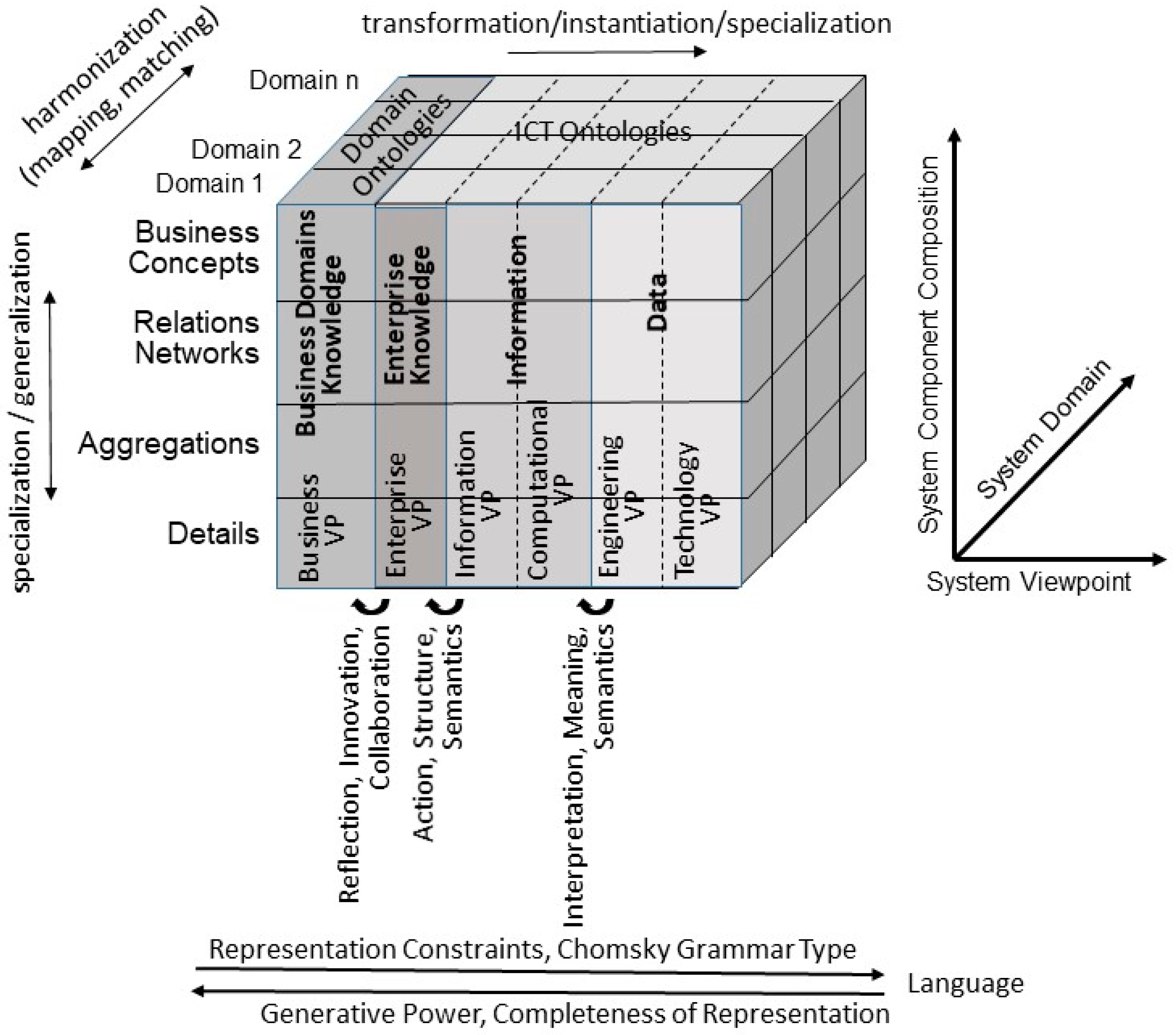
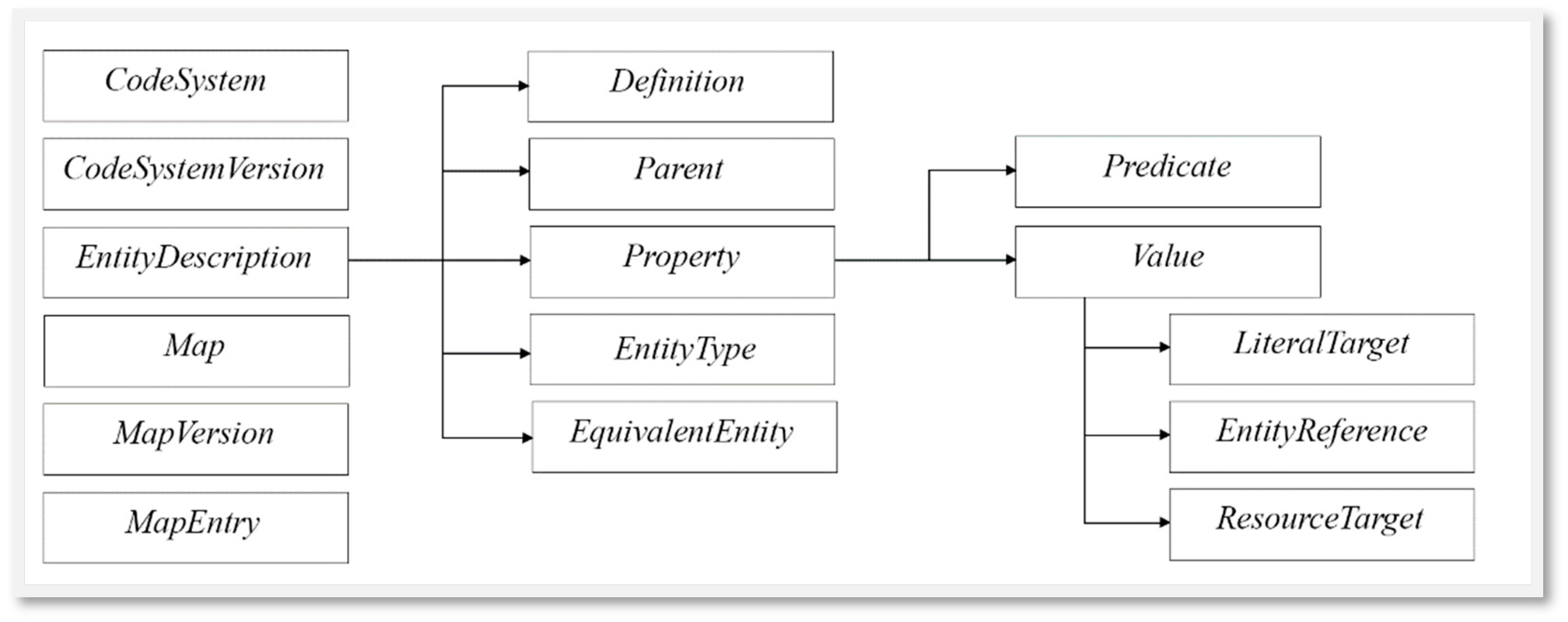
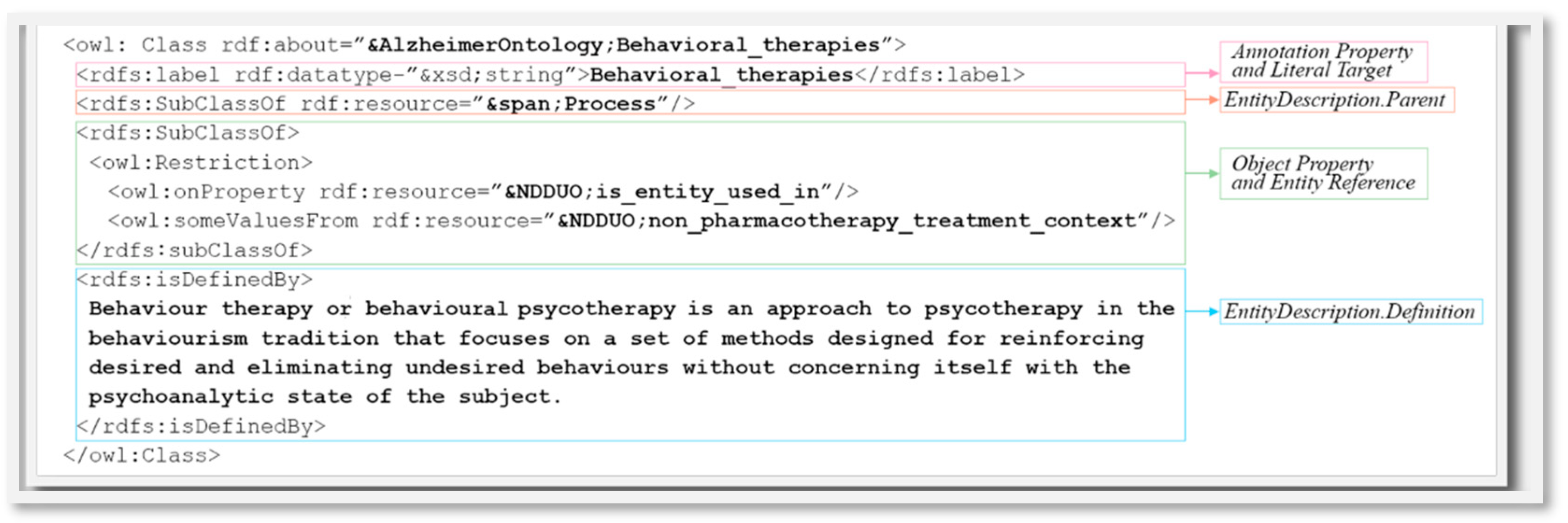
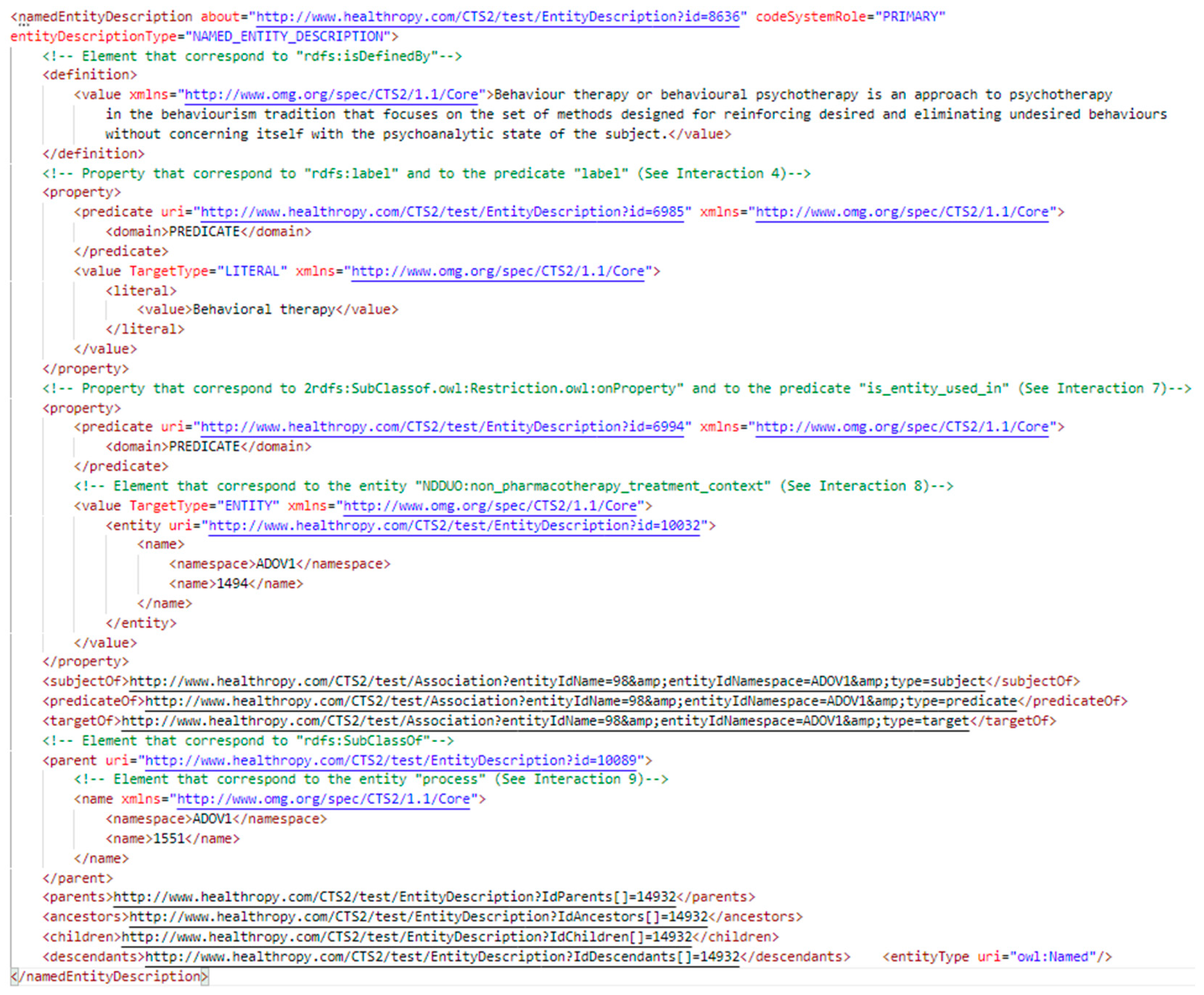
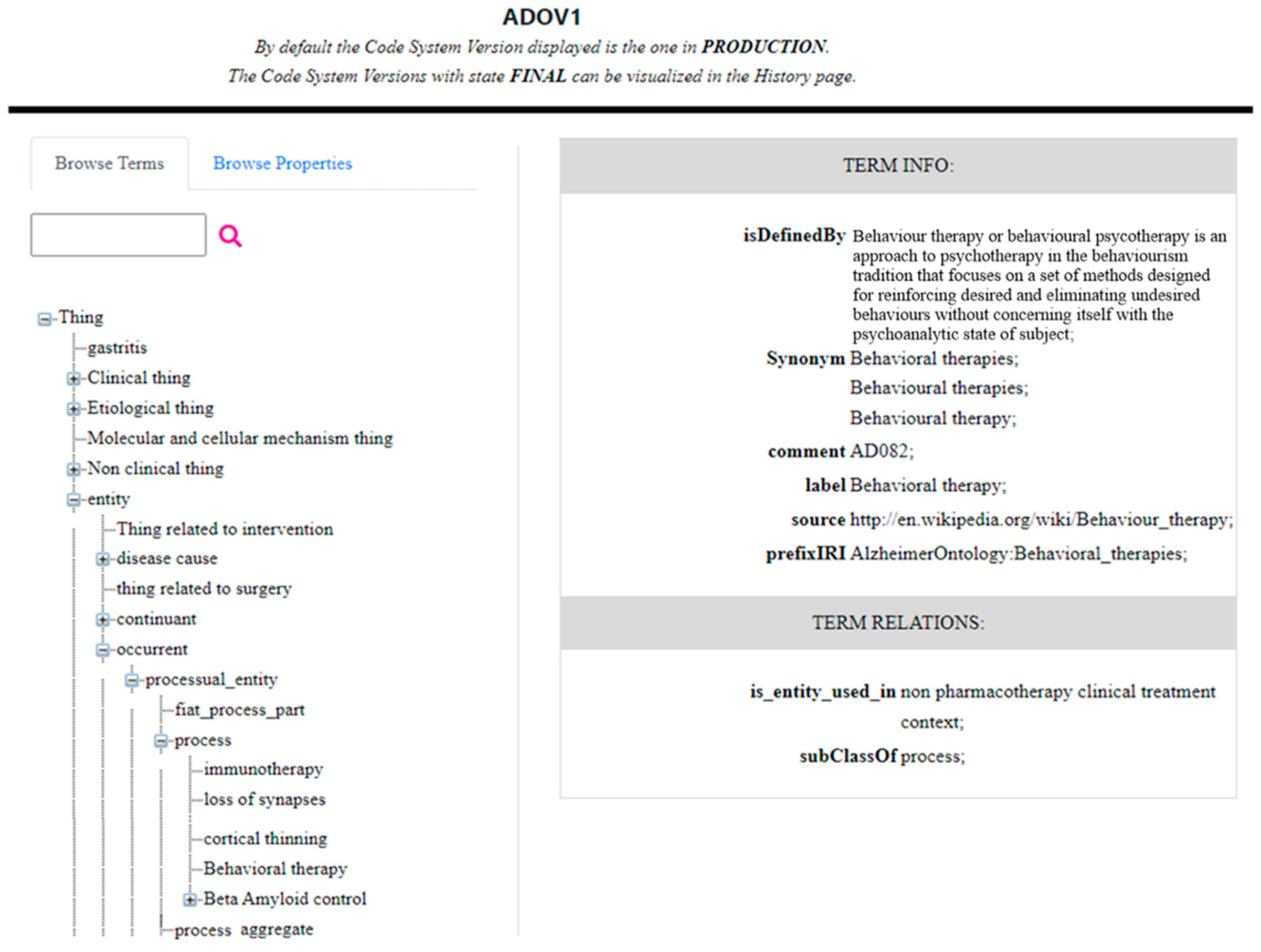
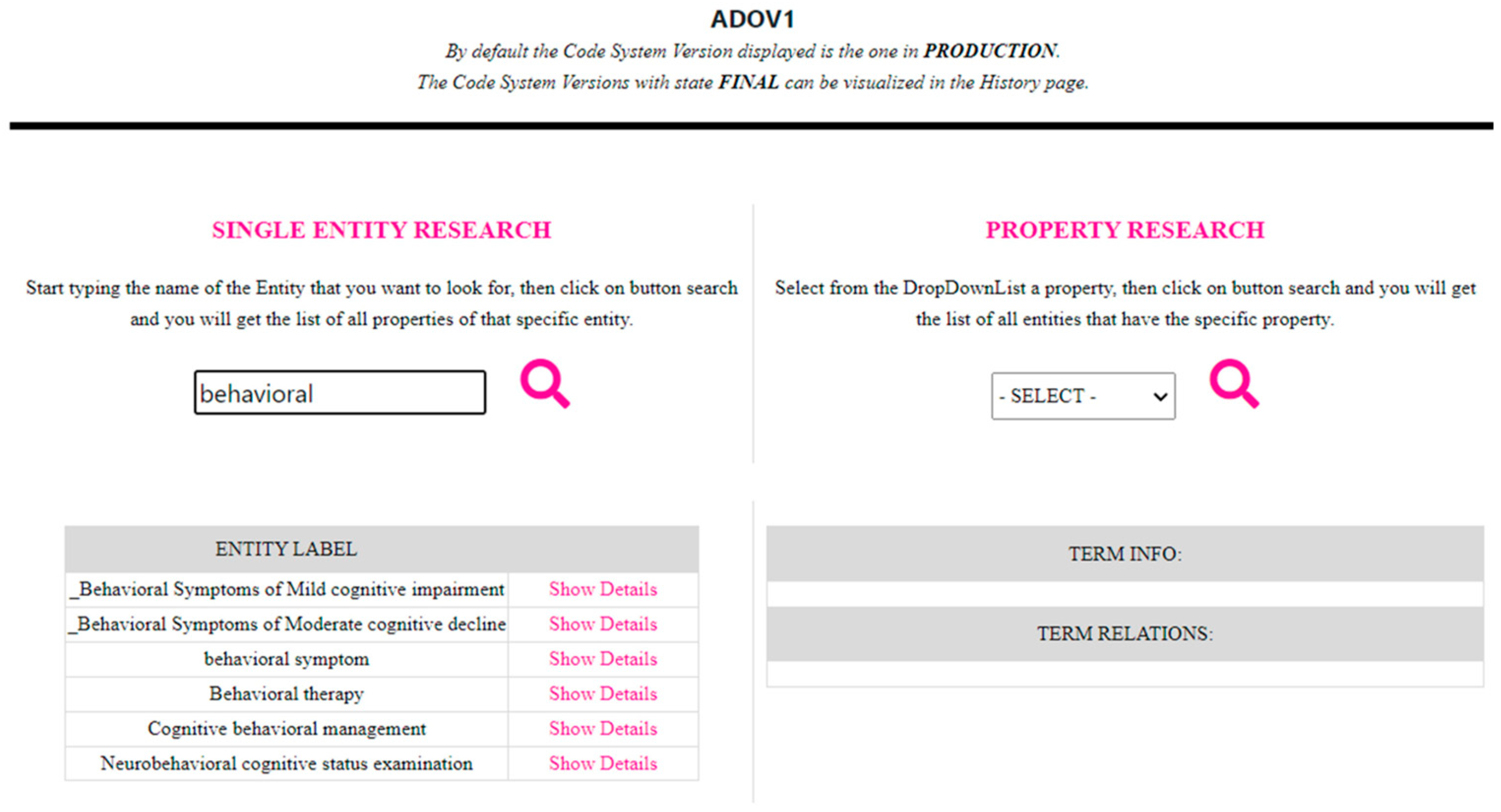

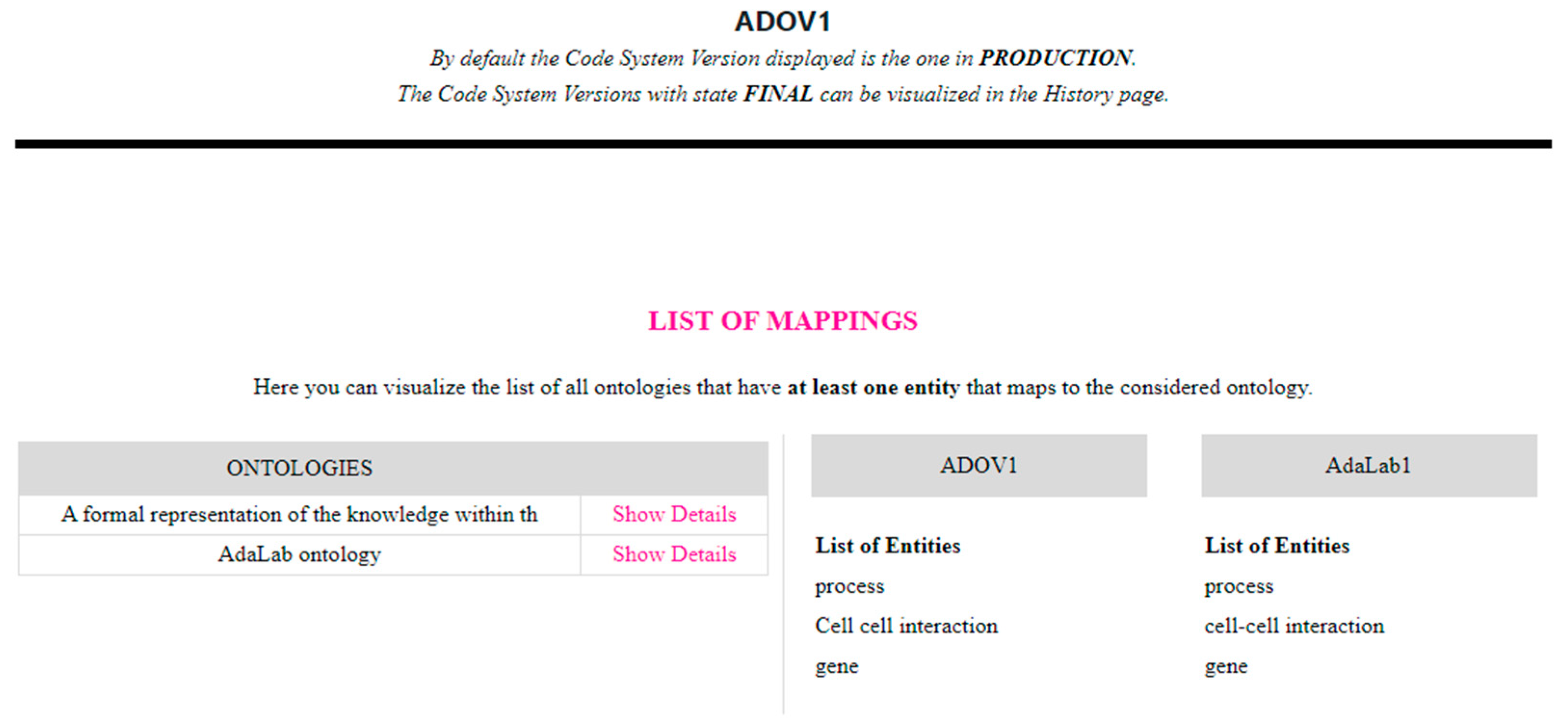
Disclaimer/Publisher’s Note: The statements, opinions and data contained in all publications are solely those of the individual author(s) and contributor(s) and not of MDPI and/or the editor(s). MDPI and/or the editor(s) disclaim responsibility for any injury to people or property resulting from any ideas, methods, instructions or products referred to in the content. |
© 2024 by the authors. Licensee MDPI, Basel, Switzerland. This article is an open access article distributed under the terms and conditions of the Creative Commons Attribution (CC BY) license (https://creativecommons.org/licenses/by/4.0/).
Share and Cite
Mora, S.; Gazzarata, R.; Blobel, B.; Murgia, Y.; Giacomini, M. Transforming Ontology Web Language Elements into Common Terminology Service 2 Terminology Resources. J. Pers. Med. 2024, 14, 676. https://doi.org/10.3390/jpm14070676
Mora S, Gazzarata R, Blobel B, Murgia Y, Giacomini M. Transforming Ontology Web Language Elements into Common Terminology Service 2 Terminology Resources. Journal of Personalized Medicine. 2024; 14(7):676. https://doi.org/10.3390/jpm14070676
Chicago/Turabian StyleMora, Sara, Roberta Gazzarata, Bernd Blobel, Ylenia Murgia, and Mauro Giacomini. 2024. "Transforming Ontology Web Language Elements into Common Terminology Service 2 Terminology Resources" Journal of Personalized Medicine 14, no. 7: 676. https://doi.org/10.3390/jpm14070676
APA StyleMora, S., Gazzarata, R., Blobel, B., Murgia, Y., & Giacomini, M. (2024). Transforming Ontology Web Language Elements into Common Terminology Service 2 Terminology Resources. Journal of Personalized Medicine, 14(7), 676. https://doi.org/10.3390/jpm14070676







